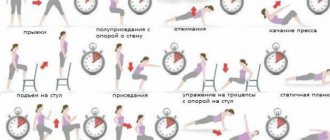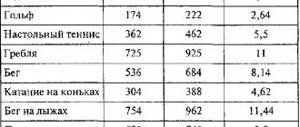Author: Timko Ilya - the ruler of the entire site and fitness trainer | more details >> Rod. 1984 Trained since 1999 Trained since 2007. Author and creator of the site tvoytrener.com. CCM in powerlifting. Champion of Russia and South Russia according to AWPC. Champion of the Krasnodar region according to IPF. 1st category in weightlifting. 2-time winner of the Krasnodar Territory championship in t/a. Author of more than 700 articles on fitness and amateur athletics. Author and co-author of 5 books.
Place in the author rating:
out of competition
(become an author) Date: 2015-05-24 Views: 84,653 Rating: 5.0
| All articles by the author >> | Medals articles >> |
Articles are loading...
I get asked this question quite often. And this is not an idle question. Indeed, the number of workouts per week (density) greatly influences the results. And humanity (and me personally) has long determined the optimal number of workouts per week. This is what we will talk about.
What is the best training frequency?
You already understand that all strategies are effective, and you are wondering whether one of the options will be better or worse than the other. Yes! Choosing the best strategy depends on individual factors, especially your skill level. That's what it means.
- Beginners.
If you are new to strength training (that is, you have been training regularly and properly for less than 6-8 months), all the research, expert recommendations and practical experience suggest that 3 workouts per week is ideal for you. The example given split (3 workouts for the whole body) is the optimal choice recommended for all beginners. - Intermediate and advanced level.
For anyone who has passed the beginner stage (that is, has been training regularly and competently for more than 6-8 months), research, expert advice and practical experience agree that a frequency of two workouts per week is ideal. The example of the split given earlier (2 workouts each for the upper and lower body) will be the optimal choice. This is the strategy most often recommended by the most educated people in the iron world.
But what about 1 workout per week?
Although training each muscle group once a week is most popular among average gym goers, it also turns out to be the least effective for most. Is the strategy working? Without a doubt (provided you do everything right). Is it the best for most of us? Absolutely not.
A whole week of rest between training a specific muscle group is a serious waste of time, no matter how it is served. Judge for yourself. The muscle receives 52 training sessions per year. If you train her 2 times a week, she gets 104 training sessions per year. What strategy do you think will give the best results in the future over the same period of time? The answer is obvious, isn't it?
If so, why is the option of one muscle group workout per week so popular? Because it is great for people who use various "support" (i.e. pharmacology and steroids), people with excellent genes and bodybuilders who have already almost fully realized their muscle-building potential.
All these people look amazing. We want to be like them and try to imitate them. The only problem is that we are average, normal people training without “support”, and such a strategy will be less effective over the long term. Scientific research and real-life examples prove this.
Key Point: All strategies work!
I want to focus your attention on the fact that any frequency of training can bring results. But the only way to make the strategy work is to match training volume and frequency. Let me explain.
Let's say for a muscle group, 12 sets is the ideal weekly training volume. Your personal optimal load depends on thousands of individual factors, but 12 sets is a fairly reasonable number and very convenient for our example. So that's what I mean...
- If you train each muscle group once a week, you should complete all 12 sets at once. Since the training frequency is low, you have to do a week's work at a time. So, 12 sets for a muscle group 1 time per week = weekly training volume of 12 sets. Mission Complete.
- If you train a muscle group 3 times a week, you should perform approximately 4 sets per muscle group for each of the three weekly workouts. Because the frequency of strength training is high, you have to dramatically reduce the volume of load per workout to adapt to the frequency. If you do 4 sets per muscle group 3 times a week, you'll get a total weekly volume of 12 sets. Mission accomplished again.
- If you train a muscle group 2 times a week, you should do 6 sets per muscle group in each of your two weekly workouts. The frequency of training can be called moderate, so you need to work with a moderate load that corresponds to this frequency. By performing 6 sets for each muscle group 2 times a week, we get a weekly volume of 12 sets. And again we state that the mission is accomplished.
Regardless of the training frequency you choose, you distribute the load so that your optimal weekly training volume remains the same (12 sets in this example). Just make sure that the volume of the load in one session corresponds to the frequency of the training impact, and by the end of the week you will not exceed the norm and will not find yourself far behind the ideal weekly volume.
Comment.
The 12 sets per muscle per week principle applies primarily to the larger muscle masses of the chest, back, and legs. For small muscles, such as biceps and triceps, half the load is enough.
And now the most important question...
Recommendations
- Once a week. I generally DO NOT recommend this strategy. If your only goal is to maintain strength and your current level of muscle development, and not increase them, then you can, but otherwise, completely abandon this irrelevant style of strength training. He is the least productive of all.
- Three times a week. I strongly recommend this frequency of training for beginners, regardless of their goals (muscle growth, fat burning, increasing strength). My #1 recommendation is to use the full body split I gave as an example.
- Two times a week. I recommend this training frequency for most people. This has been proven to be the ideal training frequency and is best for most people (except beginners) who want to build muscle, lose fat, and increase strength. There are several ways to make the strategy work, but my favorite remains the top/bottom split above. This is the only split I use today.
Still have questions? The articles on our resource will help you answer them. From them you will learn about proven programs that are actively used and recommended by famous representatives of the world of fitness and bodybuilding.
In addition, you will find on the site a complete guide on how to build muscle, burn fat, or solve both problems as quickly and efficiently as possible. The publications contain answers, details and facts that will make diet and exercise programs productive and help both men and women completely transform their bodies.
How many times to train?
The optimal frequency of training is determined, first of all, by the main purpose of visiting the gym - from building muscle mass to increasing endurance or losing weight. This is what affects how many days the body needs to recover.
If long-term, but relatively light, cardio training for burning fat can be done 4-5 times a week, then strength training for the purpose of muscle growth definitely requires more time for recovery - the most effective frequency would be 3-4 visits to the gym per week.
Scientific studies show that the time it takes for muscles to recover is between 48 and 72 hours. In reality, the figure depends both on the total training experience and the age of the person (the older he is, the longer the recovery takes), and on which muscles were involved in the work.
Small and medium muscle groups (arms, shoulders, abs) require about 48-60 hours for regeneration, and for complete recovery of muscles and the central nervous system after basic exercises and working out large muscle groups (legs, chest, back) at least 72 hours are needed (1).
Muscle pain after exercise
If, after exercise, you feel specific “delayed” pain in your muscles (usually it begins 12 to 24 hours after exercise and ends 24 to 72 hours later), this means that the body is repairing muscles and removing toxins formed after exercise.
It is generally believed that this pain is directly related to muscle growth. This is not entirely true, and muscle growth can occur without pain - it all depends on the individual characteristics of a person’s metabolism. Note that active recovery and sports massage significantly reduce delayed pain.
Active recovery
Oddly enough, complete rest is not the optimal way to restore muscles - moderate physical activity on rest days from strength training increases blood flow and the rate of removal of toxins from the body, thus accelerating the processes of regeneration and growth of muscle tissue.
Light cardio exercise (rowing machine or elliptical) lasting 20-25 minutes on days free from strength training will not only speed up recovery, but will also have a positive effect on muscle definition. A visit to the sauna or water area of a fitness club may also be helpful.
How many times a week should you train?
To summarize, the optimal training frequency for gaining mass is to work out in the gym 3-4 times a week. Each major muscle group is worked no more than once every 72 hours - if you trained your chest on Monday, it’s better to train it next time on Thursday or Friday.
At the same time, the recovery time also depends on the body type - athletic mesomorphs can train more often and build muscle faster, while the body of thin ectomorphs or overweight endomorphs requires an increased amount of time to replenish energy reserves.
How many times a week should you train your abs?
For beginners, in the first months of training, you can pump up your abs 5 times a week - the presence of “delayed” pain will help you literally feel your abdominal muscles, which will dramatically increase the effectiveness of your training. However, we are talking about performing single exercises at home.
Full sets of exercises for developing abdominal muscles will require the usual 48-60 hours for recovery. More frequent training of the abdominal muscles will not be able to remove the belly faster (this requires a diet), and will only cause overtraining and negatively affect progress.
Frequency of training for weight loss
Speaking about pumping up abs and creating a flat stomach, we note that more frequent workouts to burn fat will give the opposite effect to the desired one. Accelerating metabolism while reducing caloric intake will lead to an increase in the hormone cortisol, which provokes the growth of belly fat.
Losing weight should always begin with normalizing your diet, eliminating fast carbohydrates and excessively high-calorie foods. Various workouts for burning fat are only a way to normalize metabolism, and not a mechanism for directly burning calories.
***
Since muscle recovery time is 48 hours for small muscle groups and 72 hours for large muscle groups, strength training for mass gain is best done 3 to 4 times a week. Workouts for weight loss can be done more frequently, but without a drastic reduction in caloric intake.
Scientific sources:
- The Truth About Muscle Recovery Time, source
Source: https://fitseven.ru/myschtsy/kak-nakachatsa/3-ili-4-raza-v-nedelyu











